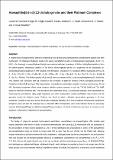Files in this item
Acenaphtho[5,6-cd]-1,2-dichalcogenoles and their platinum complexes
Item metadata
| dc.contributor.author | Diamond, Louise | |
| dc.contributor.author | Knight, Fergus Ross | |
| dc.contributor.author | Cordes, David Bradford | |
| dc.contributor.author | Ward, Andrew Christopher Clifford | |
| dc.contributor.author | Slawin, Alexandra Martha Zoya | |
| dc.contributor.author | Woollins, J Derek | |
| dc.date.accessioned | 2015-09-05T23:11:00Z | |
| dc.date.available | 2015-09-05T23:11:00Z | |
| dc.date.issued | 2015-01-08 | |
| dc.identifier | 169383491 | |
| dc.identifier | 322f3d6b-c468-4ca6-a410-671b38a1b212 | |
| dc.identifier | 000347582900050 | |
| dc.identifier | 84907656701 | |
| dc.identifier.citation | Diamond , L , Knight , F R , Cordes , D B , Ward , A C C , Slawin , A M Z & Woollins , J D 2015 , ' Acenaphtho[5,6-cd]-1,2-dichalcogenoles and their platinum complexes ' , Polyhedron , vol. 85 , pp. 395-404 . https://doi.org/10.1016/j.poly.2014.08.046 | en |
| dc.identifier.issn | 0277-5387 | |
| dc.identifier.other | ORCID: /0000-0002-5366-9168/work/28024019 | |
| dc.identifier.other | ORCID: /0000-0002-9527-6418/work/56861392 | |
| dc.identifier.other | ORCID: /0000-0002-1498-9652/work/31779189 | |
| dc.identifier.uri | https://hdl.handle.net/10023/7407 | |
| dc.description | The work in this project was supported by the Engineering and Physical Sciences Research Council (EPSRC). | en |
| dc.description.abstract | A related series of bis(phosphine) platinum complexes 1–5 and 6–8 bearing dichalcogenate acenaphthylene ligands have been synthesised. The chalcogen–chalcogen bonds in the parent acenaphtho[5,6-cd]-1,2-dichalcogenoles (AcenapylE2; L1 E = S, L2 E = Se; Acenapyl = acenaphthylene-5,6-diyl) were reduced with two equivalents of lithium triethylborohydride to form the dilithio-species. Metathetical addition of the lithium dichalcogenate species to a suspension of the appropriate cis-dichlorobis(phosphine)platinum in THF resulted in the formation of platinum(II) complexes [Pt(5,6-AcenapylE2)(PR3)2] (1 E = S, R3 = Ph3; 2 E = S, R3 = Ph2Me; 3 E = S, R3 = PhMe2; 4 E = S, R3 = Me3; 6 E = Se, R3 = Ph3; 7 E = Se, R3 = Ph2Me; 8 E = Se, R3 = PhMe2). The dilithio-species of L1 and L2 were also reacted with (1,5-cyclooctadiene)platinum(II) dichloride. This reaction was successful with L1 resulting in the formation of platinum complex [Pt(5,6-AcenapylS2)(COD)] (5). Complexes 1–3 and 5–8 have been fully characterised, principally by multinuclear magnetic resonance spectroscopy, IR and MS. Secondary isotopomer effects create complex satellite systems observed in both the 31P{1H} NMR and 77Se NMR spectra of selenium complexes 6–8. X-ray structures were determined for L1, 1, 3 and 6 and analysed, where appropriate, by measuring the peri-distance, splay angle magnitude, peri-atom displacement, central naphthalene ring torsions and the geometry around the platinum centre. Platinum was found to adopt a distorted square-planar geometry in all three complexes. Complex 1 was found to have the greatest molecular distortion of all three complexes, showing that changing the phosphine group and also the chalcogen has a noticeable effect. Comparisons were made between 6 and our previously reported [Pt(NapSe2)(PPh3)2] and [Pt(AcenapSe2)(PPh3)2] complexes; the level of distortion was found to decrease as the backbone is altered from naphthalene to acenaphthylene. | |
| dc.format.extent | 10 | |
| dc.format.extent | 827214 | |
| dc.language.iso | eng | |
| dc.relation.ispartof | Polyhedron | en |
| dc.subject | Chalcogen | en |
| dc.subject | Acenaphthylene | en |
| dc.subject | Platinum | en |
| dc.subject | X-ray structure | en |
| dc.subject | Coordination complex | en |
| dc.subject | QD Chemistry | en |
| dc.subject | DAS | en |
| dc.subject.lcc | QD | en |
| dc.title | Acenaphtho[5,6-cd]-1,2-dichalcogenoles and their platinum complexes | en |
| dc.type | Journal article | en |
| dc.contributor.institution | University of St Andrews. School of Chemistry | en |
| dc.contributor.institution | University of St Andrews. EaSTCHEM | en |
| dc.contributor.institution | University of St Andrews. Office of the Principal | en |
| dc.identifier.doi | 10.1016/j.poly.2014.08.046 | |
| dc.description.status | Peer reviewed | en |
| dc.date.embargoedUntil | 2015-09-06 | |
| dc.identifier.url | http://www.sciencedirect.com/science/article/pii/S0277538714005695#appd001 | en |
This item appears in the following Collection(s)
Items in the St Andrews Research Repository are protected by copyright, with all rights reserved, unless otherwise indicated.

